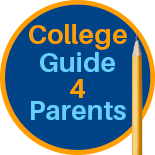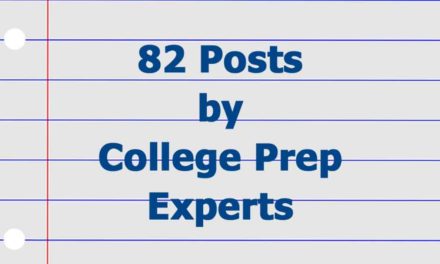This issue of College Guide 4 Parents’ College Application News focuses on financial aid (the FAFSA and the CSS Profile), college decision notifications, and high school clubs.
This month, seniors who applied early are starting to receive college decision notifications.
In this newsletter, we focus on:
- the FAFSA
- the CSS Profile
- College decision notifications
- High school clubs
1.FAFSA (Free Application for Federal Student Aid)
Now that your child has sent in her/his applications, it is time to work on financial aidstarting with the FAFSA. The Department of Education’s Federal Student Aid Office uses the information you enterin this online form to assess how much financial aid your student will receive in the form of federal grants or loans.
The application
The application consists of two parts, one to be filled out by your child and one by you. First you create separate FAFSA login IDs and then you each answer questions about your income, assets, expenses, and any governmental assistanceyou may be receiving like child support, food allowance, or veterans benefits.
The Federal Student Aid office will use the data you provide to compute your Expected Family Contribution (EFC).It is the amount the federal government believes your family can afford to pay yearly towards college.If you get a low EFC, your child will probably qualify for a Pell Grant. If, on the other hand, your EFC is high, the government will expect your family to pay most of the college attendance cost. Your child will, however, qualify for some federal loans.
The financial aid award letter
When filling out the FAFSA, your child must include the names of the schools she/he is applying to. This allows the Federal Student Aid Office to let these institutions know how much federal grants or loans your child is eligible for. When a college notifies a student that she/he has been accepted, it also sends a financial aid award letter listing the federal financial aid made available to her/him, any scholarships the state or the college may offer, and the college attendance cost your family will be responsible for.
It is important to remember that you must complete the FAFSA for every year your child attends college. Each time, the EFC will be based on the previous year’s tax return. Therefore, if one year you earn a lot less or a lot more than the previous one, the amount of financial aid will likely be very different.
Finally, while your child may not qualify for a lot of federal aid, it is worthwhile to file the FAFSA anyway because some states and colleges use the EFC to award additional scholarships.
Other facts about the FAFSA:
1. The FAFSA application becomes available to you a year before your child is planning to start college, and the financial information you provide must come from the tax returns of the previous year. For instance, for seniors applying to start college in fall 2019, the FAFSA was made available on October 1, 2018. In this case, parents are expected to use their 2017 tax returns to fill out the form.
2. The deadline to complete the FAFSA application is June of your child’s college freshman year. However, since the available grant money is allocated on a first come first served basis, it is best to apply early.
3. Applying for the FAFSA is free.
Related online resources:
The website hosting the FAFSA application.
This worksheet gives you a preview of the questions you will be asked while completing the online FAFSA form.
Paper version of the FAFSA (PDF format – 8 Pages)
Paper version of the FAFSA application. It includes an explanation for each question.
Trending FAQs about the FAFSAby the Department of Education
Answers to the most frequently asked questions about the FAFSA.
FAFSA walkthrough video by Khan Academy
Khan Academy made a video that explains how to complete the FAFSA.
FAFSA YouTube videos by the Department of Education
YouTube videos on how to complete the FAFSA.
Simple explanation: what is FAFSA by PrepScholar
This post introduces the FAFSA, what you need in order to apply, and what happens after you submit the form.
In-depth guide about completing the FAFSA. It also includes information about how to review your child’s aid award package and how to appeal the decision.
Don’t file the FAFSA until you read this! by CollegeAdmissionsHQ
This article recommends to examine your finances before applying for the FAFSA and provides tips to lower your family’s EFC.
Your EFC: what it is, how it’s calculated, and why it matters by CollegeAdmissionsHQ
A post about how your EFC is calculated. It includes a breakdown of the assets used to compute the EFC like for instance how much of the parents’ and student’s incomes are taken into account.
Maximizing FAFSA and Pell Grants by MoneySmartFamily.com
This post guides you through the completion of the FAFSA but also provide a list of the assets that must be reported and those that do not need to be.
2. CSS Profile (College Scholarship Service Profile)
While all students should file the FAFSA, the CSS Profile is required only those applying to some universities and colleges, typically ivy league schools and prestigious establishments like Johns Hopkins University or the University of Chicago (see the list of schools).
When reviewing the CSS Profile application, College Board forwards your family’s financial information to the schools you specify. Each college uses its own formula to compute your family’s Expected Family Contribution (EFC) and decide how much of its own need-based scholarship funds your child is eligible for.
The CSS Profile is designed to provide a more comprehensive representation of a family’s financial healththan the FAFSA. For this reason, it asks about your and your child’s federal income tax returns, W-2 forms, records of untaxed income, bank statements, mortgage information, and investment and trust documents.Fortunately, it also takes into account your expenses. For example, it asks for the size of the family and the number of children attending a college that year.
The cost of the application is $25. It includes the fee to send your report to one school. College Board charges $16.00 per school to send additional reports.
Universities need this report to prepare your child’s financial aid award letter. For this reason, it is best to fill out the CSS Profile application early. College app experts recommend to complete it two weeks before the due date.
Related online resources:
Website hosting the CSS Profile application.
An overview of the 2019-20 CSS Profile by CollegeBoard
Slideshow about the 2019-20 application
CSS Profile walkthrough by Khan Academy
7 videos that explain the steps involved in completing the CSS Profile application.
The ultimate guide to completing the CSS Profile by GoingMerry.com
This post guides you through the various sections of the CSS Profile application.
2017 Guide To College Financial Aid, The FAFSA And CSS Profile by Forbes
A lot of financial tips about the FAFSA and CSS Profile and how your salary or assets may affect your child’s chances to qualify for financial aid.
2019-20 List of universities, colleges, and scholarships requiring the CSS Profile by CollegeBoard
Only some colleges require you to complete the CSS Profile. Some scholarship funds also rely on that information to select the students they will give money to. This list includes all the organizations that require the CSS Profile in 2019.
3. COLLEGE APP – WHAT TO DO THIS MONTH
Seniors who applied early are starting to receive their college decision notifications
While students often send out several college applications, they usually have favorites. As a parent, you may worry about your child’s reaction if she/he does not get into any of them.
In this month’s newsletter, we will look at what college experts recommend students do when their applications are accepted, deferred, waitlisted, or denied.
Being accepted
For students who sent in an early decision application: if the college did accept them, they must withdrawall their other college applications.
When a college accepts a student, the letter specifies a date by which she/he must respond to be officially enrolled. This date is usually a few months away. Students, therefore, can wait for all their other college decision notifications to come in before choosing which school they will attend.
It is also time to make sure the colleges that have accepted your teen have all the required financial information. It will allow them to decide how much need-based aid they will give her/him. The first step is to complete the FAFSA. You and your child may also have to file the CSS Profile application.
Being deferred
A college may defer a student’s application for many reasons. If your child still wants to attend that school, an article by Forbes recommends to contact the college and ask why she/he was deferred and what she/he can do to strengthen her/his application.The school may, for instance, have decided to wait for the latest grades or test scores.
Being Waitlisted
Being put on a waitlist means that the college has already accepted enough students to fill its freshmen class. Depending on how high your teen is on the list, she/he may still have a chance to be accepted.Indeed, most students apply to several colleges, and when they decide on the one they will attend, they turn down the other colleges’ offers. Once all students have responded, usually in May, schools offer the newly opened spots to those on the waitlist.
If an ivy league school waitlisted your child, her/his chances to be accepted are slim. TopTierAdmissions explains that these schools admit less than 2% of the students placed on their waitlists. TopTierAdmissions advises students to refocus their energy on applying to schools that accept rolling admissions.It also recommends that seniors review their original applications and identify ways they can make their new ones stronger.
Being denied
If your child’s first choice school rejected her/his application, it is, of course, a big letdown. However, according to an article by Forbes,rejection from one’s first choice may lead to a more fulfilling college experience:
The truth is, identifying whyyou want to go to college is more important than determining whereyou will go. Often, students who are not admitted to their dream school are the most appreciative of, and intentional about, their college experience. Consider a denial of admission an invitation to focus less on which school you will attend, and instead, prioritize what you do while you are there. A 2018 report from the organization Challenge Successhighlighted the notion that engagement in collegerather than selectivity is a better predictor of learning, fulfillment, and well-being.
Students applying for Rolling Admissions
Those applying for Rolling Admissionshave a little more time to put their applications together. See our October and Novemberissues for a description of a typical college application, information about the ACT, and tips on getting good letters of recommendations. Check also our post about writing good college essays.
Related online resources:
Early application outcomes: how to deal by IvyWise.com
This post provides advice about the next steps to take if a student is accepted, deferred, or rejected by a college. It also includes a video that discusses what to do if an application is deferred.
How to deal with a deferral or denial of admission to college: change priorities by Forbes
This post looks at the positive outcomes that can be brought about by a deferral or denial of admission. It includes the testimony of several college admissions officers.
What to do if you have been deferred by TopTierAdmissions
Advice on what actions to take when an application has been deferred.
Waitlisted? Take action now! by TopTierAdmissions
This article focuses on students waitlisted by ivy league schools.
IMPORTANT DATES
| TEST NAME | TEST DATE | REGISTRATION DEADLINE | LATE REGISTRATION DEADLINE | OFFICIAL WEBSITE |
| ACT | February 9, 2019 | January 11, 2019 | January 12-18, 2019 | act.org |
| ACT | April 13, 2019 | March 8, 2019 | March 9-25, 2019 | act.org |
| SAT | March 9, 2018 | February 8, 2019 | February 27, 2019 | collegeboard.org |
| AP Exams | May 6-17, 2019 | collegeboard.org |
4. FEATURE OF THE MONTH: Getting involved in high school clubs
As part of their college applications, seniors are expected to highlight their interests, passions, and talents. If your child does not yet know what she/he is interested in, you may wonder how she/he will be able to discover what she/he is passionate about. Getting involved in school clubs is a great place to start.
How school clubs help students identify their passions
Many students in 9th or 10th grade do not know what their passions are. A good way for them to find out is to try a variety of activities in different fields. Members of school clubs are exposed to different disciplines, learn new skills, and get to volunteer. These experiences help them discover fulfilling ways to spend their free time and, in the process, identify their passions and interests.
While the recommendation for 9th graders is to participate in many clubs, older students must not overextend themselves. As they progress through high school, they will need to focus on the areas that interest them most. This will allow them to do well in class while gaining the experiences they will need to build strong college apps.
For example, a student interested in medical professions may participate in a medicine-related club, volunteer in local hospitals, shadow a doctor, and attend a summer medical camp.
Those who like being involved in their community, are interested in government or enjoy public speaking can join their school’s Model UN, Model Arab League, or debate team, as well as participate in programs organized by their city or state.
Students passionate about saving the environment can become a member of their school’s environmental club and volunteer for city cleanups and recycling efforts.
Those enjoying technology can join an engineering, robotics or programming club, and register for summer camps in these fields.
Students passionate about arts, creative writing, or music, can participate in a club related to these fields as well as enter local and state competitions.
Joining school clubs
Participating in a club will involve attending a weekly meeting and probably helping in a few events. If the school allows students to join and quit clubs at any time during the school year, your child may want to try out most of her/his school’s organizations to see which ones she/he likes.
Here are some popular clubs your child may be able to join:
Related to academic subjects
Philosophy club, History club, Spanish, French, German, or Chinese club, Math club
Technology-oriented
Engineering, Robotics, and Programming clubs
Related to the medical field
HOSA, Biomedical club
About arts and writing
Arts club, Fine Arts club, Photography club, Book club, Authors club
About politics
Young Democrats , Young Republicans
Others
An environment-related club, Chess club, Fashion club, Culture club, Movie club
If your child would like to join a club that her/his school does not offer, she/he can ask about creating it. Being responsible for the creation of a new club looks very good on a college application. PrepScholar has written a guide about “How to start a club in your high school”.
Schools usually offer three types of clubs
1. Specific to the school
Some clubs exist only at your teen’s school. It means that some fellow students came up with the idea for a new club, defined its purpose and rules, and submitted the paperwork to get it registered with the school. Examples are Movie club, History club, and Culture club.
2. A local chapter of a national organization
Others are local chapters of clubs that exist nationally. In these cases, members must also follow the rules set by the national organizations.
For instance, members of the Mu Alpha Theta Math club must participate in one math competition and volunteer as a math tutor.
The National Honors Society club accepts only a few students per school and requires the school to create a committee that will select the new members. In order to stay in that organization, the selected students must volunteer four hours per quarter.
HOSA is another nationwide club that is for future health professionals.
3. Competition-driven clubs
Some clubs exist for the sole purpose of preparing for and participating in competitions.
A school’s Model UN team registers to compete in state and regional events.
The Quiz Bowl and Science Bowl teams have to learn facts and represent their school in local competitions. If their team wins, it is invited to compete at the state level.
Many high schools have a FIRST Robotics Competition Team. Participating students build a robot and enter several competitions a year.
Related online resources:
How to determine which clubs to join: a guide to freshmen by CollegeVine
An article to help freshmen select which clubs to select.
A guide to extracurricular activities for Grade 9 by CollegeVine
Why and how to get involved in extracurricular activities in 9th grade.
30 high school clubs you can start now by CollegeVine
Description of 30 popular high schools clubs
Complete list of extracurricular activities: 100s of examples by PrepScholar
PrepScholar provides an extensive list of activities your child can join as well as advice on how she/he can narrow down which ones would be best for her/him.
How to start a club in high school: 8-step guide by PrepScholar
A post that lists reasons to start a school club, explains how to define its purpose and goals, register it with the school, and assign duties.
5. PREVIOUS COLLEGE GUIDE 4 PARENTS’ APP NEWS AND RELATED POSTS
Topics : What is a good ACT score, obtaining good letters of recommendation, documenting your child’s extracurricular activities
October 2018 College App News – ACT Superstore, Sending Scores, College Essays
Topics : ACT scores vs. superscores, test-flexible schools, how to send scores, and how starting extracurricular activities as early as 9th grade will help when writing college essays
September 2018 College App News – PSAT, ACT, Early Action, Early Decision
Topics: 2018 PSAT test, taking the ACT in the fall, and volunteering before senior year
2018-19 College Essay Advice: 82 Posts by College Prep Experts
This article contains links to 82 posts about writing this year’s college essays, like the Common Application, Coalition Application and ApplyTexas essay prompts, and the application and supplemental essays for 62 popular colleges including several ivy league schools, the universities of New York and California, and Texas A&M.
6. REQUEST FOR COMMENTS
If this information were of help to you or if there are topics you would like me to address, please leave a comment.





